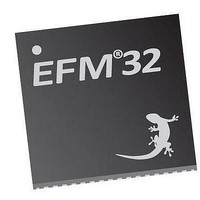EFM32TG210F32 Energy Micro, EFM32TG210F32 Datasheet - Page 101

EFM32TG210F32
Manufacturer Part Number
EFM32TG210F32
Description
MCU 32BIT 32KB FLASH 32-QFN
Manufacturer
Energy Micro
Series
Tiny Geckor
Specifications of EFM32TG210F32
Core Processor
ARM® Cortex-M3™
Core Size
32-Bit
Speed
32MHz
Connectivity
EBI/EMI, I²C, IrDA, SmartCard, SPI, UART/USART
Peripherals
Brown-out Detect/Reset, DMA, POR, PWM, WDT
Number Of I /o
24
Program Memory Size
32KB (32K x 8)
Program Memory Type
FLASH
Ram Size
4K x 8
Voltage - Supply (vcc/vdd)
1.8 V ~ 3.8 V
Data Converters
A/D 4x12b, D/A 1x12b
Oscillator Type
External
Operating Temperature
-40°C ~ 85°C
Package / Case
32-VQFN Exposed Pad
Processor Series
EFM32
Core
ARM Cortex-M3
Data Bus Width
32 bit
Data Ram Size
32 KB
Interface Type
UART, I2C, SPI
Maximum Clock Frequency
32 MHz
Number Of Programmable I/os
17
Number Of Timers
1
Operating Supply Voltage
1.8 V to 3.8 V
Maximum Operating Temperature
+ 85 C
Mounting Style
SMD/SMT
Processor To Be Evaluated
EFM32TG210
Lead Free Status / RoHS Status
Lead free / RoHS Compliant
Eeprom Size
-
Lead Free Status / Rohs Status
Details
- Current page: 101 of 522
- Download datasheet (9Mb)
11.3.3.2 HFRCO, LFRCO and AUXHFRCO
2010-12-21 - d0034_Rev0.90
Figure 11.5. LFXO Pin Connection
It is possible to connect an external clock source to HFXTAL_N/LFXTAL_N pin of the HFXO or LFXO
oscillator. By configuring the HFXOMODE/LFXOMODE fields in CMU_CTRL, the HFXO/LFXO can be
bypassed.
It is possible to calibrate the HFRCO, LFRCO and AUXHFRCO to achieve higher accuracy (see the
device datasheets for details on accuracy). The frequency is adjusted by changing the TUNING fields in
CMU_HFRCOCTL/CMU_LFRCOCTRL/CMU_AUXHFRCOCTRL. Changing to a higher value will result
in a higher frequency. Please refer to the datasheet for stepsize details.
The HFRCO and AUXHFRCO can be set to one of several different frequency bands from 1 MHz to 28
MHz by setting the BAND field in CMU_HFRCOCTRL and CMU_AUXHFRCOCTRL.The HFRCO and
AUXHFRCO frequency bands are calibrated during production test, and the production tested calibration
values can be read from the Device Information (DI) page. The DI page contains a separate tuning value
for each frequency band. During reset, HFRCO and AUXHFRCO tuning values are set to the production
calibrated values for the 14 MHz band, which is the default frequency band. When changing to a different
HFRCO or AUXHFRCO band, make sure to also update the tuning value.
The LFRCO and is also calibrated in production and its TUNING value is set to the correct value during
reset.
The CMU has built-in HW support to efficiently calibrate the RC oscillators at run-time, see Figure 11.6 (p.
102) The concept is to select a reference and compare the RC frequency with the reference frequency.
When the calibration circuit is started, one down-counter running on a selectable clock (DOWNSEL
in CMU_CALCTRL) and one up-counter running on a selectable clock (UPSEL in CMU_CALCTRL)
are started simultaneously. The top value for the down-counter must be written to CMU_CALCNT
before calibration is started. When the down-counter has reached 0, the up-counter is sampled and the
CALRDY interrupt flag is set. If CONT in CMU_CALCTRL is cleared, the counters are stopped at this
point. If continuous mode is selected by setting CONT in CMU_CALCTRL the down-counter reloads the
top value and continues counting and the up-counter restarts from 0. Software can then read out the
sampled up-counter value from CMU_CALCNT. Then it is easy to find the ratio between the reference
and the oscillator subject to the calibration. Overflows of the up-counter will not occur. If the up-counter
reaches its top value before the down counter reaches 0, the top counter stays at its top value. Calibration
can be stopped by writing CALSTOP in CMU_CMD. With this HW support, it is simple to write efficient
calibration algorithms in software.
C
L1
32.768kHz
C
L2
...the world's most energy friendly microcontrollers
101
LFXTAL_N
LFXTAL_P
EFM32
www.energymicro.com
Related parts for EFM32TG210F32
Image
Part Number
Description
Manufacturer
Datasheet
Request
R

Part Number:
Description:
KIT STARTER EFM32 GECKO
Manufacturer:
Energy Micro
Datasheet:

Part Number:
Description:
KIT DEV EFM32 GECKO LCD SUPPORT
Manufacturer:
Energy Micro
Datasheet:

Part Number:
Description:
BOARD PROTOTYPING FOR EFM32
Manufacturer:
Energy Micro
Datasheet:

Part Number:
Description:
KIT DEVELOPMENT EFM32 GECKO
Manufacturer:
Energy Micro
Datasheet:

Part Number:
Description:
MCU, MPU & DSP Development Tools TG840 Sample Kit
Manufacturer:
Energy Micro
Datasheet:

Part Number:
Description:
MCU, MPU & DSP Development Tools TG Starter Kit
Manufacturer:
Energy Micro
Datasheet:

Part Number:
Description:
MCU, MPU & DSP Development Tools TG108 Sample Kit
Manufacturer:
Energy Micro

Part Number:
Description:
MCU, MPU & DSP Development Tools TG210 Sample Kit
Manufacturer:
Energy Micro
Datasheet:

Part Number:
Description:
MCU, MPU & DSP Development Tools TG822 Sample Kit
Manufacturer:
Energy Micro
Datasheet:

Part Number:
Description:
MCU, MPU & DSP Development Tools TG230 Sample Kit
Manufacturer:
Energy Micro

Part Number:
Description:
SAMPLE KIT (SMALL BOX - CONTAINING 2 DEVICES)
Manufacturer:
Energy Micro

Part Number:
Description:
SAMPLE KIT (SMALL BOX - CONTAINING 2 DEVICES)
Manufacturer:
Energy Micro










